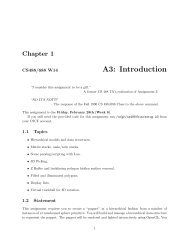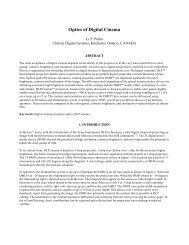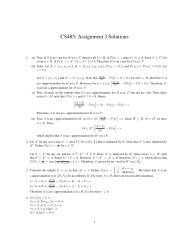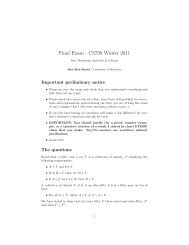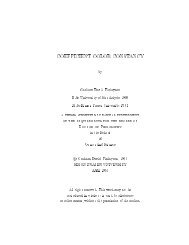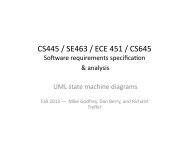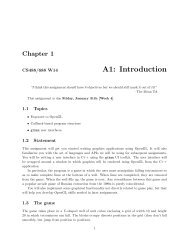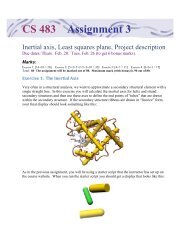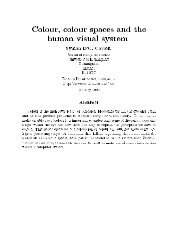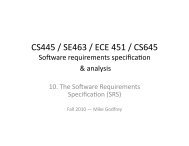Past Midterm and Exam Questions (PDF) - Student.cs.uwaterloo.ca ...
Past Midterm and Exam Questions (PDF) - Student.cs.uwaterloo.ca ...
Past Midterm and Exam Questions (PDF) - Student.cs.uwaterloo.ca ...
Create successful ePaper yourself
Turn your PDF publications into a flip-book with our unique Google optimized e-Paper software.
CS488/688 Introduction to Computer Graphi<strong>cs</strong> 25<br />
Describe what would you would do to implement each of the five virtual devices of (b) using<br />
only the trackball. The lo<strong>ca</strong>tor you implement should be a 3D lo<strong>ca</strong>tor. (You may assume that<br />
there is screen feedback provided; i.e., rolling the ball left/right moves the cursor horizontally,<br />
rolling the ball up/down moves the cursor verti<strong>ca</strong>lly, <strong>and</strong> twisting the ball makes the cursor<br />
blink.)<br />
11 Modeling<br />
11.1 Tetrahedron [Last Used: Spring 2000 Final]<br />
Consider the tetrahedron whose vertices are A = (1, 1, 1), B = (0, 1, 1), C = (0, 0, 1), <strong>and</strong> D =<br />
(0, 0, 0).<br />
(a) What are the normals of the four triangles that bound the tetrahedron?<br />
(b) Assume that the eyepoint is at the point (-1,-1,-1). Which triangles (ABC, ABD, ACD, or<br />
BCD) are backfacing?<br />
(c) Assume that a light source is at the point (−∞,0,0), has intensity 10.0, <strong>and</strong> all faces of the<br />
tetrahedron have a diffuse reflectivity coefficient of 1.0. Compute the light due to diffuse<br />
reflection from all four faces of the tetrahedron.<br />
(d) Describe how to <strong>ca</strong>lculate vertex normals given the normals for each surface of an object.<br />
Calculate the vertex normals for the tetrahedron.<br />
11.2 Cube Projected as Hexagon [Last Used: Winter 1992 MidTerm]<br />
A cube viewed in parallel projection along a body diagonal (corner to corner through the centre of<br />
the cube) has a hexagonal cross-section. The objective of this question is to show the sequence of<br />
transformations needed to place a cube in space so that a hexagon appears on the display.<br />
Suppose that you have viewing parameters given by:



